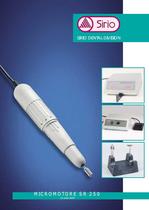

- Products
- Catalogs
- News & Trends
- Exhibitions
Dental laboratory micromotor SR 250electric
Add to favorites
Compare this product
Characteristics
- Applications
- for dental laboratories
- Operation
- electric
- Speed
Min.: 2,000 rpm
(12,566.4 rad.min-1)Max.: 25,000 rpm
(157,079.6 rad.min-1)
Description
SR 250 - Laboratory Micromotors
SR250 laboratory micromotors
The SR 250 micromotor was developed in response to the need for a light and at the same time powerful and reliable instrument. It can be used to process resins, hard metals and ceramics, fully satisfying the productivity and ergonomic requirements of a modern dental laboratory.
SR 250P Foot version.
The control is placed on the floor and activated with the foot. To turn on and start the machine move with your foot the feeder lever from its central position, either to the left or the right. Use the same lever to regulate the handpiece rotation speed: the more you move the lever, the more the speed will increase. Maximum speed is reached with the lever all the way to the right or the left. By releasing the lever, this will go back to its central position and the micromotor will come to a halt.
SR 250T Table version.
The control is placed on the table and the foot/lever ON/OFF on the floor. To turn on the machine press the main switch located on the feeder front panel. To regulate the handpiece rotation speed, rotate the knob potentiometer, also located on the front panel: the speed increases by rotating the knob clockwise. By pressing the foot pedal you start the handpiece, and the speed will increase to the set potentiometer level. By releasing the foot pedal, the micromotor will come to a halt.
Catalogs
*Prices are pre-tax. They exclude delivery charges and customs duties and do not include additional charges for installation or activation options. Prices are indicative only and may vary by country, with changes to the cost of raw materials and exchange rates.




